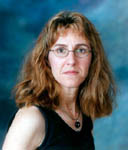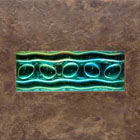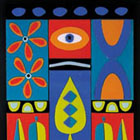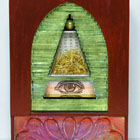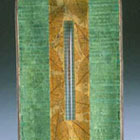SHERYL ELLINWOOD
artwork | audio | statement | galleries
artwork
audio 
(see also Making Art in Iowa and Art & Spirituality)
- College (59 sec. | 409KB): listen | read
- Sculpture professor (65 sec. | 449KB): listen | read
- Blowing glass v. sculpture (39 sec. | 268KB): listen | read
- Artwork (61 sec. | 420KB): listen | read
- Mystery (59 sec. | 410KB): listen | read
- Advice (44 sec. | 302KB): listen | read
artist statement
Sculptural Work
As a sculptor, I work with ideas and choose forms and materials that metaphorically resonate those ideas: that embody the seemingly inexpressible. It is within this context that I utilize the inherent qualities of glass, along with a variety of other materials and "found" objects.
In my work, the process of stacking or layering glass makes reference to reincarnation—a concept of successive periods of life, death and rebirth through which one attains elightenment. While this technique creates a visually dazzling surface, a fools gold if-you-will, the true meaning is discovered only by looking beyond the surface, just as enlightenment is attained by being freed from the cycle of rebirth.
The incorporation of text in many of the works is not intended to provide instant access, but rather to form another layer of meaning—one that is only accessible through much effort, but ultimately attainable.
As one's relationship with the natural world is the foundation upon which the view of all else is formed, this is a fundamental concept that often reccurs in my work.
My use of the simple house-form is directly tied to its universal symbolism for the self. This "reading" creates an essential framework within which beliefs about reality, our connection to the natural world and the very nature of existance itself can be explored on a personal level. By exaining these concepts in the light of differing worldviews, I aim to reexamine questions we think we know the answers to. For this reason, my sculptures are more about looking into rather than looking at.
audio text
College
When I was 17, I got a full-time job working for Blue Cross and Blue Shield. I worked for them for twelve years. I started out as a file clerk, and then I ended up as an account executive. I applied for a promotion to be an account executive, and it required a four-year bachelor's degree in marketing. And I didn't have one. But I had so much experience with the company that they gave me the job under the condition that I would get the degree and they would pay for me to get the degree.
So I started going to college for this marketing degree, which halfway through I thought, "How can anyone want to get a marketing degree?!" So I started taking art classes as electives. And that's when the light went off. I found that I dreaded going to the marketing classes. And I kept signing up for more and more art classes. I was a year away from getting my marketing degree, and then I switched majors. Well, in one week I went in and I quit my job, I told my husband I wanted a divorce, and dropped my marketing major, and even switched schools.
Sculpture professor
I went and talked to the sculpture professor, and he hated glass-blowers, which for me at that point was devastating. So, he said, "Well, I'll let you into my sculpture program, but you're going to have to learn how to do everything else like everybody else does. If you want to use glass in some of your pieces, I'll look at them, but don't ever show me anything that you've made off the blow-pipe." So, what he did to me at that point was the best thing that anyone could have done, because it forced me to realize first of all, glass-blowing is not art, and to look at glass entirely differently. Because then [in] my sculptures, if I was going to use glass, I had to look at the material more metaphorically instead of just, "Well, here's a blown glass vase and let's sit it on here and now it's art." So, that was just a real good thing that happened.
And then the last thing he said to me was a year before I graduated. He says, "Okay, now you've mastered all these techniques. Now I want you to get some content in your work." And that was the first time I really grappled with art and content and how the two had to be together. Those were the two things that have totally affected my career and my thinking about art.
Blowing glass v. sculpture
It's a nice job. I enjoy blowing glass, I mean, don't get me wrong. It's very creative. It's not art, but it is creative, and to me those two are very, very separate. I don't know that I could do sculpture year round—I mean, every day—because where art comes from and where my sculpture comes from, it's so gut-wrenching in a sense. This is not superficial stuff. This is not deciding what shape the bowl's going to be and what color and how big. This is grappling with things that are in your subconscious and how to get those across and what does this mean. So it's really emotionally stressful. So, in a way I'm really kind of thankful for the glass-blowing, because that's like a no-brainer.
Artwork
My sculpture, I would describe as being intense—not intense visually, but intense mentally if you'll allow yourself to think about it. And they're kind of a trick. At first glance, because they have glass in them, and they have a lot of gold on them a lot of times, or silver, they're very appealing to the eye. Immediately, they pull people to them. And then when they get close and really start investigating the piece, I've never had anyone not turn and ask me a question. And that's good. I mean, that's what they're supposed to do. They're supposed to ask some pretty important questions.
My work is very refined. I think that all art has to have craftsmanship about it. Work that's sloppily done—that poor craftsmanship becomes part of the content of the piece, and will destroy the piece because you can't get past that. So, I'm real meticulous about everything in the piece being done perfectly.
Mystery
I think that art work has to be universal, and so you have to rise above that trying to be preachy kind of thing in your work, because it never works to tell someone what to think. You effect change in people by making them question what they think themselves. I think you have to be more subversive than that, and connect on a deeper, different level.
I think if there's one thing that I would like people to come away from the piece is just a renewed sense in the mystery of our existence and our relation to the earth and each other and ourselves. My problem with religion is that religions say they can answer those questions. The fact of the matter is they can't. Because as soon as you give someone a pat answer, it removes the mystery and the questioning and the seeking. So, that's what I want people to come away from these pieces, is a renewed sense of mystery and questioning.
Advice
If you want to be an artist and go get another job—fine, do it. If you want to be an artist and make a living as an artist, my first advice would be, if you don't love this above anything else, if you wouldn't sacrifice just about everything for it, then don't do it because it won't work. Get yourself a full-time job and do it on the side as a hobby. But if you love nothing more than doing your artwork, then, I would say, "Do it. Go for it." Because it will work. But also be realistic. Most artists are just plain hard-working people, period. And it takes more hard work than it takes talent. So, I guess I would say, if you're not prepared for hard work, go get a job.

